- SilverWare
- Wooden Furniture & Craft
- Wooden Nautical Gift
- Wooden Block
- Wooden Rehal[Book Reading]
- Wooden Table Corner
- Wooden Incense Stick Burner
- Wooden Cutlery & Cigar Pipe
- Wooden Almira
- Wooden Walking Stick & Stand
- Wooden New Development Furniture
- Wooden Lamp
- Wooden Dinning Set
- Wooden Chess & Game Box
- Wooden Chess
- Wooden Mango Wood European Style Furniture
- Wooden Extension
- Wooden Drawer
- Wooden Meena Work Antique
- Wooden Teak Wood European Style Furniture
- Wooden bed side
- Wooden Photo Frame
- Wooden binary table
- wooden bench
- Wooden Office Desk
- Wooden Jewellery
- Wooden Swing
- wooden drawer chest
- Wooden Tvc
- Wooden Stationary
- Wooden Table Piller
- wooden wine bar
- Wooden Mislinius Furniture
- Wooden Pen Holder & Pen Box
- Wooden Box
- wooden chair
- Wooden Screen
- Wooden House Hold Product
- Wooden Ash Tray
- Wooden Side Board
- Wooden Mirror Frame
- Wooden Coaster
- Wooden Candle Stand
- Wooden Table Octangle
- ALUMINIUM
- Musical Instrument
- Stallone Pig Bristle
- Rugs & Carpet
- Stone Product
- IRON WARE
- Zinc Oxide
- GUAR GUM
- Brass Nautical & Marine Re-Production Instrument
- Brass Clinometer
- Brass Abney Level
- Brass candle stand
- Brass Ship Clock
- Sailers Wheel
- Brass Microscope
- Brass Flower Base
- Brass Ship Telegraph
- Brass Ship Anchor
- Brass Porthol Window
- Brass Photo Frame
- Brass Sextant
- Brass Mix Nautical Gift
- Brass Weather Instrument
- Brass Ashtray
- Brass Sand Timer
- Brass Boat Horn
- Brass Ship Bell
- BRASS CHRISTMAS DECORATIVE
- Brass Theodolite
- Brass Divider
- Brass Vernier Caliper
- Brass Kitchenware
- Brass Surveying Level
- Brass Nautical Key Chain
- Brass Pully [Reel]
- Brass Napkin Ring
- Brass Diving Helmet
- Brass Magnifier
- Brass Rain Guage
- Brass Bottle Opener
- Brass Ship Lamp
- Brass Compass
- Brass Lamp
- Brass T Light Holder
- Brass Globe
- Brass Porthol Mirror
- Brass Binoculers
- Brass Search Light
- BrassWare New Range
- Brass Flag Hook
- Brass Measurement Tape
- Brass Telescope
- Brass Gong
- Medieval Armoury
- Bronze Statue
- Home
- About us
- ShopNew

50% OFF FOR
New collection
Free shipping & free returns on dresses

Hot week
Discover the selection
Shipping worldwide only 5 days - Executive Member
- Contact us
- SilverWare
- Wooden Furniture & Craft
- Wooden Nautical Gift
- Wooden Block
- Wooden Rehal[Book Reading]
- Wooden Table Corner
- Wooden Incense Stick Burner
- Wooden Cutlery & Cigar Pipe
- Wooden Almira
- Wooden Walking Stick & Stand
- Wooden New Development Furniture
- Wooden Lamp
- Wooden Dinning Set
- Wooden Chess & Game Box
- Wooden Chess
- Wooden Mango Wood European Style Furniture
- Wooden Extension
- Wooden Drawer
- Wooden Meena Work Antique
- Wooden Teak Wood European Style Furniture
- Wooden bed side
- Wooden Photo Frame
- Wooden binary table
- wooden bench
- Wooden Office Desk
- Wooden Jewellery
- Wooden Swing
- wooden drawer chest
- Wooden Tvc
- Wooden Stationary
- Wooden Table Piller
- wooden wine bar
- Wooden Mislinius Furniture
- Wooden Pen Holder & Pen Box
- Wooden Box
- wooden chair
- Wooden Screen
- Wooden House Hold Product
- Wooden Ash Tray
- Wooden Side Board
- Wooden Mirror Frame
- Wooden Coaster
- Wooden Candle Stand
- Wooden Table Octangle
- ALUMINIUM
- Musical Instrument
- Stallone Pig Bristle
- Rugs & Carpet
- Stone Product
- IRON WARE
- Zinc Oxide
- GUAR GUM
- Brass Nautical & Marine Re-Production Instrument
- Brass Clinometer
- Brass Abney Level
- Brass candle stand
- Brass Ship Clock
- Sailers Wheel
- Brass Microscope
- Brass Flower Base
- Brass Ship Telegraph
- Brass Ship Anchor
- Brass Porthol Window
- Brass Photo Frame
- Brass Sextant
- Brass Mix Nautical Gift
- Brass Weather Instrument
- Brass Ashtray
- Brass Sand Timer
- Brass Boat Horn
- Brass Ship Bell
- BRASS CHRISTMAS DECORATIVE
- Brass Theodolite
- Brass Divider
- Brass Vernier Caliper
- Brass Kitchenware
- Brass Surveying Level
- Brass Nautical Key Chain
- Brass Pully [Reel]
- Brass Napkin Ring
- Brass Diving Helmet
- Brass Magnifier
- Brass Rain Guage
- Brass Bottle Opener
- Brass Ship Lamp
- Brass Compass
- Brass Lamp
- Brass T Light Holder
- Brass Globe
- Brass Porthol Mirror
- Brass Binoculers
- Brass Search Light
- BrassWare New Range
- Brass Flag Hook
- Brass Measurement Tape
- Brass Telescope
- Brass Gong
- Medieval Armoury
- Bronze Statue
SA0243 Barbute Helmet – Early Medieval
Barbute Helmet – Early Medieval
Barbute Helmet – Early Medieval
The defining characteristic of the barbute is the helmet’s downward extension,
fully covering both sides of the user’s face. Regardless of the type of opening, Tshaped, Y-shaped or arch-shaped, this characteristic was always present. This
helmet design enabled the user to wear a gorget.[2] In place of a plate gorget, the
barbute was often worn with a stiffened mail collar, termed a “standard,” which
protected the throat and neck. In some examples, there is a central, narrow
protrusion extending down from the top of the opening, designed to protect the
wearer’s nose. Sometimes, like Italian sallets, barbutes were covered by a rich
decorative fabric, typically heavy velvet.Unlike the sallet, the barbute seems to
have enjoyed little popularity outside Italy.The main differences between the
barbute and the Greek hoplite’s helm to which it is often compared is the
difference in material and the lack of a prominent decorative crest. Ancient
Greeks used bronze, while most barbutes were constructed of steel.Barbutes were
made most commonly from a single sheet of steel using the metal smithing process
of raising until the piece assumed the desired shape. Many barbutes feature a low
ridged crest forged into the top of the helmet’s skull which served to strengthen
the helmet without adding a significant amount of weight.
Related products
Copyright © STALLONE OVERSEAS PVT. LTD. All rights reserved.
- Home
- About us
- ShopNew

50% OFF FOR
New collection
Free shipping & free returns on dresses

Hot week
Discover the selection
Shipping worldwide only 5 days - Executive Member
- Contact us




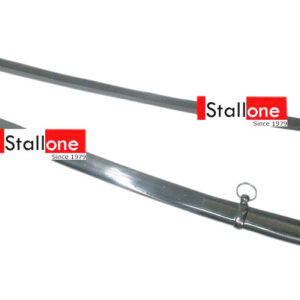
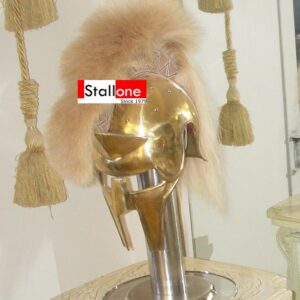
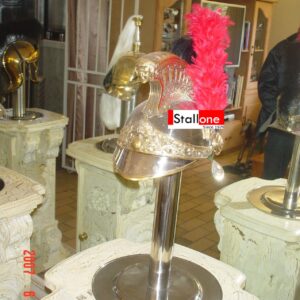
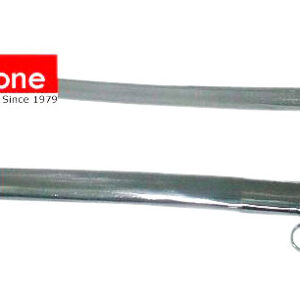
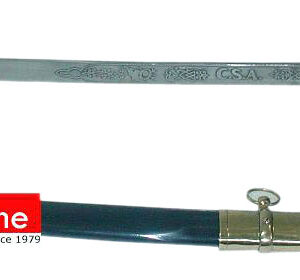
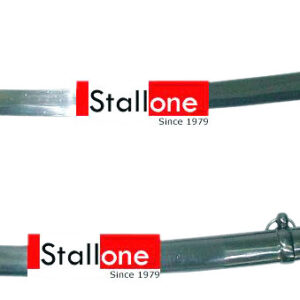
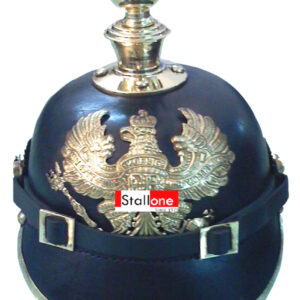
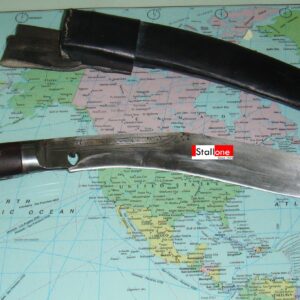
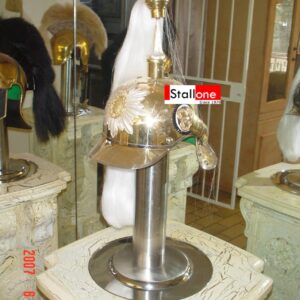
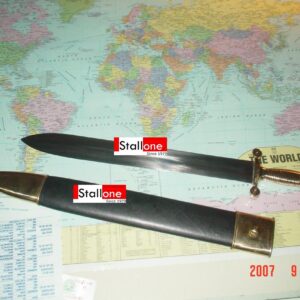
Reviews
There are no reviews yet.